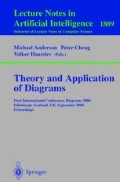Abstract
This paper extends work that developed a programmed model of reasoning about geometric propositions. The system reasons by manipulating representations of diagrams and noticing newly emerged facts that are construed as inferences. The system has been explored as a means of verifying diagrammatic demonstrations of classical geometric propositions and for constructing diagrammatic demonstrations of conclusions supplied for the system. The process of discovering propositions to be demonstrated is a more difficult task. This paper argues that central to the discovery process is systematic manipulation of diagrams - playing - and observing consistent relations among features of the diagram as manipulations are made and observed. The play results in the creation of an “episode” of diagram behaviors which is examined for regularities from which a general proposition might be proposed. The paper illustrates this process and discusses the advantages and limitations of this system and of other computational models of diagrammatic reasoning.
Access this chapter
Tax calculation will be finalised at checkout
Purchases are for personal use only
Preview
Unable to display preview. Download preview PDF.
References
Lindsay, R.K.: Qualitative Geometric Reasoning. In: Proceedings of the Eleventh Annual Conference of the Cognitive Science Society (Ann Arbor, MI). Lawrence Erlbaum, Hillsdale, NJ (1989) 418–425
Lindsay, R.K.: Diagrammatic Reasoning by Simulation. In: Reasoning with Diagrammatic Representations. Technical Report SS-92-02. American Association for Artificial Intelligence, Menlo Park, CA (1992) 130–135
Lindsay, R.K.: Understanding Diagrammatic Demonstrations. In: Proceedings of the Sixteenth Annual Conference of the Cognitive Science Society (Atlanta, GA). Lawrence Erlbaum, Hillsdale, NJ (1994) 572–576
Lindsay, R.K.: Using Diagrams to Understand Geometry. Computational Intelligence 14(2) (1998) 222–256
Lindsay, R.K.: Knowing about Diagrams. In: Anderson, M., Olivier, P. (eds.): Reasoning with Diagrams. Springer-Verlag, Dordrecht (2000)
Gelernter, H.: Realization of a Geometry Theorem Proving Machine. In: International Conference on Information Processing. UNESCO House, Paris (1959) 273–282
Gelernter, H., Hansen, J.R., Loveland, D.W.: Empirical Explorations of the Geometry Theorem Proving Machine. In: Proceedings of the Western Joint Computer Conference. National Joint Computer Committee, New York (1960) 143–147
Nevins, A.J.: Plane Geometry Theorem Proving Using Forward Chaining. Artificial Intelligence 6 (1975) 1–23
Koedinger, K.R., Anderson, J.R.: Abstract Planning and Perceptual Chunks: Elements of Expertise in Geometry. Cognitive Science 14 (1990) 511–550
McDougal, T.F., Hammond, K.J.: A Recognition Model of Geometry Theorem Proving. In: Proceedings of the Fourteenth Annual Conference of the Cognitive Science Society (Bloomington, Indiana). Lawrence Erlbaum, Hillsdale, NJ (1992) 106–111
McDougal, T.F., Hammond, K.J.: Representing and Using Procedural Knowledge to Build Geometry Proofs. In: Proceedings of the Eleventh National Conference on Artificial Intelligence (Washington, DC). AAAI Press, Menlo Park, CA (1993)
Lindsay, R.K.: Generalizing from Diagrams. In: Cognitive and Computational Models of Spatial Reasoning. American Association for Artificial Intelligence, Menlo Park, CA (1996) 51–55
Lindsay, R.K.: Using Spatial Semantics to Discover and Verify Diagrammatic Demonstrations of Geometric Propositions. In: O’Nuallian, S. (ed.) Spatial Cognition. John Benjamins, Amsterdam (2000) 199–212
Lenat, D.: AM: An Artificial Intelligence Approach to Discovery in Mathematics as Heuristic Search. Doctoral dissertation, Stanford University (Computer Science Department Report CS-76-57) (1976)
Langley, P.: BACON-1: A General Discovery System. In: Proceedings of the Second National Conference of the Canadian Society for Computational Studies inIntelligence. (1978) 173–180
Langley, P., Bradshaw, G.L., Simon, H.A.: BACON-5: Discovery of Conservation Laws. In: Proceedings of the Seventh International Joint Conference on Artificial Intelligence (Vancouver, British Columbia). American Association for Artificial Intelligence, Menlo Park, CA (1981)
Langley, P., Bradshaw, G.L., Simon, H.A.: Rediscovering Chemistry with the BACON System. In: Michalski, R.S., Carbonell, J.G., Mitchell, T.M. (eds.): Machine Learning. An Artificial Intelligence Approach. Tioga Press, Palo Alto, CA (1983) 307–329
Bobrow, D.G., (ed.) Qualitative Reasoning about Physical Systems. Bradford Books, Cambridge, MA (1985)
Loomis, E.S.: The Pythagorean Proposition: Its Proofs Analyzed and Classified and Bibliography of Sources for Data of the Four Kinds of Proofs. 2nd edn. Edwards Brothers, Ann Arbor, MI (1940)
Miller, N.: Case Analysis in Euclidean Geometry. Department of Mathematics, Cornell University (2000)
Newell, A.: Unified Theories of Cognition. Harvard University Press, Cambridge, MA (1990)
Anderson, J.: The Architecture of Cognition. Harvard University Press, Cambridge, MA (1983)
Furnas, G.W.: Reasoning with Diagrams Only. In: Reasoning with Diagrammatic Representations. Technical Report SS-92-02. American Association for Artificial Intelligence, Menlo Park, CA (1992) 118–123
Anderson, M., McCartney, R.: Inter-diagrammatic Reasoning. In: Proceedings of the Fourteenth International Joint Conference on Artificial Intelligence (Montreal). Morgan Kaufmann., San Mateo, CA (1995) 878–884
Author information
Authors and Affiliations
Editor information
Editors and Affiliations
Rights and permissions
Copyright information
© 2000 Springer-Verlag Berlin Heidelberg
About this paper
Cite this paper
Lindsay, R.K. (2000). Playing with Diagrams. In: Anderson, M., Cheng, P., Haarslev, V. (eds) Theory and Application of Diagrams. Diagrams 2000. Lecture Notes in Computer Science(), vol 1889. Springer, Berlin, Heidelberg. https://doi.org/10.1007/3-540-44590-0_27
Download citation
DOI: https://doi.org/10.1007/3-540-44590-0_27
Published:
Publisher Name: Springer, Berlin, Heidelberg
Print ISBN: 978-3-540-67915-8
Online ISBN: 978-3-540-44590-6
eBook Packages: Springer Book Archive

